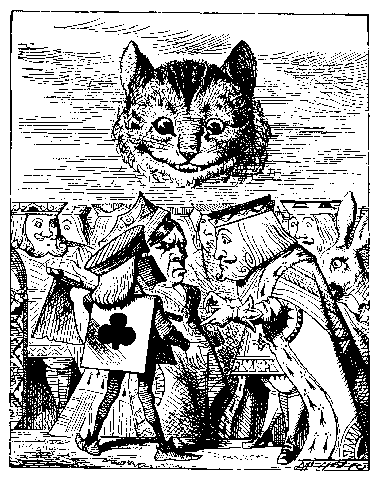
Executioner argues with King about cutting off Cheshire Cat’s head – illustration by John Tenniel (1820-1914) for Alice’s Adventures in Wonderland (1865)
The executioner’s argument was, that you couldn’t cut off a head unless there was a body to cut it off from.
The phrase a cat may look at a king means even a person of low status or importance has rights.
It was already proverbial when the English playwright and epigrammatist John Heywood (circa 1496-circa 1578) published A dialogue conteinyng the nomber in effect of all the prouerbes in the englishe tongue compacte in a matter concernyng two maner of mariages in 1546:
A cat maie looke on a kyng.
In Greenes neuer too late. Or, A powder of experience (1590), the English author Robert Greene (1558-92) wrote (swain: a male servant):
A Cat may looke at a King, and a swaynes eye hath as high a reach as a Lords looke.
The English writer Lewis Carroll (Charles Lutwidge Dodgson – 1832-98) played on the phrase in Alice’s Adventures in Wonderland (1865):
“How do you like the Queen?” said the Cat in a low voice.
“Not at all,” said Alice: “she’s so extremely—” Just then she noticed that the Queen was close behind her, listening: so she went on, “—likely to win, that it’s hardly worth while finishing the game.”
The Queen smiled and passed on.
“Who are you talking to?” said the King, going up to Alice, and looking at the Cat’s head with great curiosity.
“It’s a friend of mine—a Cheshire Cat,” said Alice: “allow me to introduce it.”
“I don’t like the look of it at all,” said the King: “however, it may kiss my hand if it likes.”
“I’d rather not,” the Cat remarked.
“Don’t be impertinent,” said the King, “and don’t look at me like that!” He got behind Alice as he spoke.
“A cat may look at a king,” said Alice. “I’ve read that in some book, but I don’t remember where.”
“Well, it must be removed,” said the King very decidedly, and he called the Queen, who was passing at the moment, “My dear! I wish you would have this cat removed!”
The Queen had only one way of settling all difficulties, great or small. “Off with his head!” she said, without even looking round.
“I’ll fetch the executioner myself,” said the King eagerly, and he hurried off.
The reason for cat and king is unknown. The same image is found in the German and Italian phrases: sieht doch die Katze den Kaiser an and un gatto può ben guardare un re. In the Spanish phrase, the animal is a dog: un perro puede mirar al rey.
The equivalent French phrase is un chien regarde bien un évêque, a dog may look at a bishop. It is first recorded in Le Moyen de parvenir. Œuvre contenant la raison de tout ce qui a été, est, et sera (The Means to succeed. A work containing the reason for all that was, is, and will be – circa 1610), by the French author François Béroalde de Verville (1556-1626):
(mid-17th-century edition?)
Voila de belles disées, de beaux dictons, c’est ce que nostre grand chien aboyoit toute nuict : mais ce qu’a chanté nostre coq, entendez-vous bien le iargon des bestes ? Parlez à ce maistre qui parloit tantost en poulle. Pourquoy non ? Vn chien abbaye bien à la Lune, & vne chéure regarde bien vn Ministre, & vn chien vn Euesque, dont moult il s’esbahit.
translation:
Those are beautiful proverbs, those are beautiful sayings, that’s what our big dog was barking all night long: but what our rooster sang, do you comprehend the beasts’ jargon? Speak to this master who just now was talking in hen language. Why not? A dog may bark at the moon, and a goat may look at a minister, and a dog at a bishop, at whom he is much amazed.
